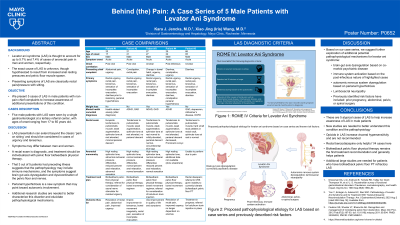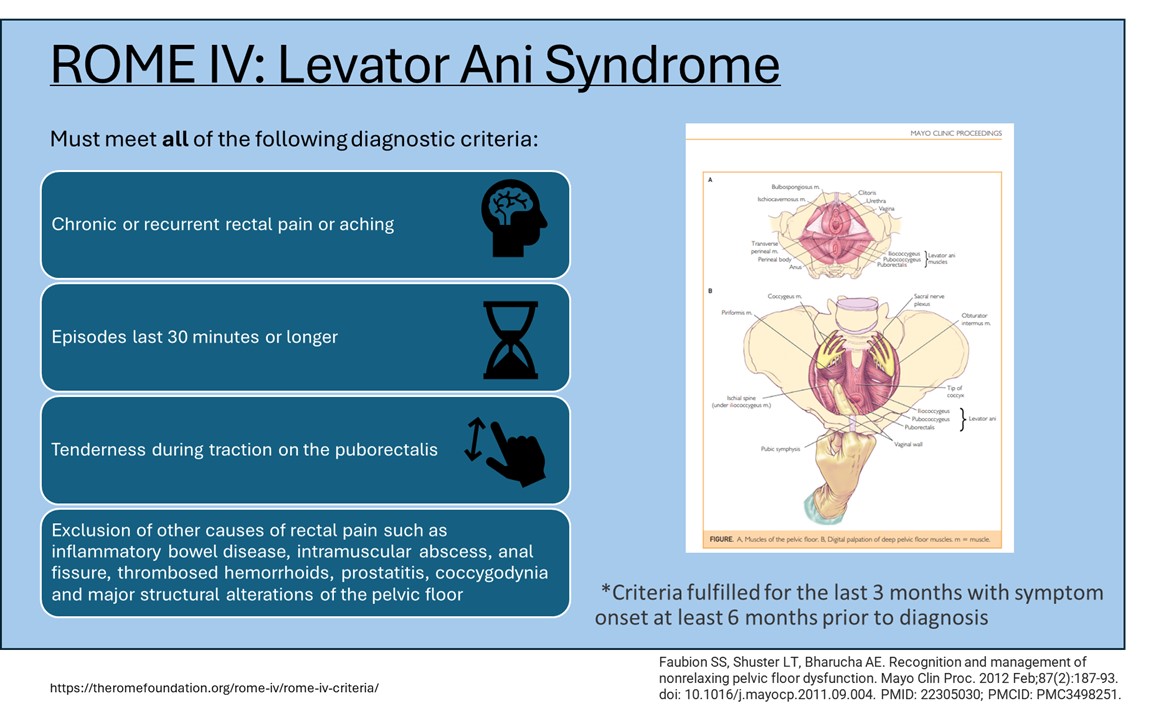Sunday Poster Session
Category: Functional Bowel Disease
P0652 - Behind (the) Pain: A Case Series of 5 Male Patients with Levator Ani Syndrome
Sunday, October 27, 2024
3:30 PM - 7:00 PM ET
Location: Exhibit Hall E

Has Audio
- KJ
Kara J. Jencks, MD
Mayo Clinic
Rochester, MN
Presenting Author(s)
Kara J. Jencks, MD, Xiao Jing (Iris) Wang, MD
Mayo Clinic, Rochester, MN
Introduction: Levator ani syndrome (LAS) is thought to account for up to 5.7% and 7.4% of cases of anorectal pain in men and women, respectively. The exact cause of LAS is unknown, though hypothesized to result from increased anal resting pressures and pelvic floor muscle spasm. Presenting symptoms are classically rectal pain/pressure with sitting. We present 5 cases of LAS in male patients with non-pain chief complaints to increase awareness of additional presentations of this condition.
Case Description/Methods: Five male patients with LAS were seen by a single gastroenterologist at a tertiary referral center. The ages of onset ranged from 17 to 65 years old. The presenting complaint for all 5 patients included urgency with 3 of the 5 seeking care for “diarrhea.” History revealed rectal discomfort, tenesmus, and a sensation of incomplete evacuation. 2 of 5 patients reported perianal hyperhydrosis which has not been documented in association with LAS. All had puborectalis tenderness on rectal exam. Anorectal manometry (ARM) showed elevated resting sphincter tone in 4 of 5 patients with one unable to tolerate ARM due to pain. Symptoms developed following an infection in 3 of 5 cases. None of these patients had a history of sexual abuse and mental health history was stable. Therapies were tailored to each patient, though generally included pelvic floor biofeedback physical therapy (resolution in one patient), bowel movement regulation, rectal diazepam, and a terminal ileostomy.
Discussion: LAS presentation can extend beyond the classic ‘pain on sitting’ and should be considered in cases of urgency and tenesmus. Symptoms may differ between men and women. A rectal exam is diagnostic, and treatment should be individualized with pelvic floor biofeedback physical therapy when able to pursue. That 3/5 patients had preceding illness suggests that the pathophysiology may include immune mechanisms, and the symptoms suggest brain gut axis dysregulation and dyscoordination of the pelvic floor and nerves. Perianal hyperhidrosis is a new symptom that may point toward autonomic involvement in some patients with LAS. Additional research studies are needed to better characterize this disorder and elucidate pathophysiological mechanisms behind why LAS occurs in general.

Note: The table for this abstract can be viewed in the ePoster Gallery section of the ACG 2024 ePoster Site or in The American Journal of Gastroenterology's abstract supplement issue, both of which will be available starting October 27, 2024.
Disclosures:
Kara J. Jencks, MD, Xiao Jing (Iris) Wang, MD. P0652 - Behind (the) Pain: A Case Series of 5 Male Patients with Levator Ani Syndrome, ACG 2024 Annual Scientific Meeting Abstracts. Philadelphia, PA: American College of Gastroenterology.
Mayo Clinic, Rochester, MN
Introduction: Levator ani syndrome (LAS) is thought to account for up to 5.7% and 7.4% of cases of anorectal pain in men and women, respectively. The exact cause of LAS is unknown, though hypothesized to result from increased anal resting pressures and pelvic floor muscle spasm. Presenting symptoms are classically rectal pain/pressure with sitting. We present 5 cases of LAS in male patients with non-pain chief complaints to increase awareness of additional presentations of this condition.
Case Description/Methods: Five male patients with LAS were seen by a single gastroenterologist at a tertiary referral center. The ages of onset ranged from 17 to 65 years old. The presenting complaint for all 5 patients included urgency with 3 of the 5 seeking care for “diarrhea.” History revealed rectal discomfort, tenesmus, and a sensation of incomplete evacuation. 2 of 5 patients reported perianal hyperhydrosis which has not been documented in association with LAS. All had puborectalis tenderness on rectal exam. Anorectal manometry (ARM) showed elevated resting sphincter tone in 4 of 5 patients with one unable to tolerate ARM due to pain. Symptoms developed following an infection in 3 of 5 cases. None of these patients had a history of sexual abuse and mental health history was stable. Therapies were tailored to each patient, though generally included pelvic floor biofeedback physical therapy (resolution in one patient), bowel movement regulation, rectal diazepam, and a terminal ileostomy.
Discussion: LAS presentation can extend beyond the classic ‘pain on sitting’ and should be considered in cases of urgency and tenesmus. Symptoms may differ between men and women. A rectal exam is diagnostic, and treatment should be individualized with pelvic floor biofeedback physical therapy when able to pursue. That 3/5 patients had preceding illness suggests that the pathophysiology may include immune mechanisms, and the symptoms suggest brain gut axis dysregulation and dyscoordination of the pelvic floor and nerves. Perianal hyperhidrosis is a new symptom that may point toward autonomic involvement in some patients with LAS. Additional research studies are needed to better characterize this disorder and elucidate pathophysiological mechanisms behind why LAS occurs in general.

Figure: Figure 1: Rome IV Criteria for Levator Ani Syndrome
Note: The table for this abstract can be viewed in the ePoster Gallery section of the ACG 2024 ePoster Site or in The American Journal of Gastroenterology's abstract supplement issue, both of which will be available starting October 27, 2024.
Disclosures:
Kara Jencks indicated no relevant financial relationships.
Xiao Jing (Iris) Wang indicated no relevant financial relationships.
Kara J. Jencks, MD, Xiao Jing (Iris) Wang, MD. P0652 - Behind (the) Pain: A Case Series of 5 Male Patients with Levator Ani Syndrome, ACG 2024 Annual Scientific Meeting Abstracts. Philadelphia, PA: American College of Gastroenterology.
